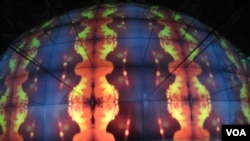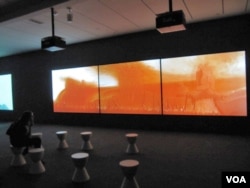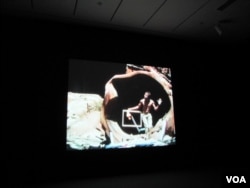Rachel Rymont did not plan to spend part of her day inside a dark museum when she came into the District of Columbia to run errands. However, one look at the National Museum of African Art’s exhibit, "Senses of Time," and the Baltimore artist was hooked.
The video and film exhibit examines how time is experienced and produced within the body. The film aspect is a big part of what sets this exhibit apart from others in the museum.
"It’s a really different experience than being in a gallery or looking at a painting," Rymont said. “It kind of forces you to step back and really co-exist with the piece instead of just glancing at it.”
The exhibit, co-organized with the Los Angeles County Museum of Art, features seven works by six artists. Though time is the theme that draws all the pieces together, the content differs wildly from piece to piece.
In "Un Ballo in Maschera," based on Giuseppe Verdi’s 1859 opera, "A Masked Ball," dancers twirl across the screen wearing elaborate costumes in old European styles fashioned from African-esque fabrics. Yinka Shonibare's piece questions the cyclical nature of time as the king, played by a woman, is assassinated, only to rise and dance once more.
Contrasting this colorful spectacle is Moataz Nasr's black-and-white film, "The Water." Faces appear onscreen framed by a puddle on the ground. Right before a viewer can make out any details, a foot stomps the image out of existence.
Art and politics
Rymont appreciated how the exhibit was political without being preachy.
“A lot of time with political work, there’s a tendency for things to get a bit cold or didactic, but that didn’t happen in there,” she said. “All of it was very moving, and it was very human.”
Sammy Baloji’s “Mémoire” is perhaps the most overtly political piece in the exhibit. Filmed against a series of abandoned copper mines in the Democratic Republic of Congo, choreographer and dancer Faustin Linyekula twists his body in an animated interpretive dance while speeches from some of the country's past and present leaders play.
The piece highlights how the present reality has failed to live up to past promises, expressed in a heartbreaking manner when Linyekula is left screaming “Vive l'independance” (Long live independence) to nothing but silence.
For Sue Williamson, who considers herself a human rights activist as well as an artist, creating "There’s Something I Must Tell You" was all about opening up channels of intergenerational discourse. In her film, six South African women, activists during the Mandela generation, tell stories of their hardships to their granddaughters and other young female relatives.
In a Skype interview with VOA, Williamson talked about how many people have important relationships with their grandmothers but don't always ask key questions before death intervenes: "You just miss the opportunity of really finding out about her life."
Living through apartheid in South Africa has influenced how Williamson incorporates social justice into her art.
"We didn’t even know when apartheid was going to end. So, as artists, there was a very strong movement in South Africa," Williamson said. "We felt it was our responsibility to work in whatever way that we could to try to change the social situation."
She said she hopes the film's stories help viewers understand the universal experiences facing women around the globe.
The human scale of time
“About to Forget” takes a more personal approach to the topic of time. In a comment on its transcendent nature, artist Berni Searle has cut three silhouettes of family images from red crepe paper, and the images dissolve on-screen as water surrounds them, resulting in scenes reminiscent of blood flowing through water.
In her second piece in the exhibit, “A Matter of Time,” Searle walks across a transparent surface that has been covered in olive oil. Every time she takes a step forward, her body inevitably slides back down the screen again.
Much like the famed Aldous Huxley novel it is named after, “Brave New World I” by Theo Eshetu focuses on the way technology warps the human experience. A TV flashes a disjointed kaleidoscope of scenes, from cute animals to the Twin Towers, but the mirrors angled around the TV turn the images into a repeating globe that captures the viewer as well.
All seven pieces play simultaneously within the exhibit hall. The effect is a viewing experience that challenges not only perceptions of time, but what the medium of film can accomplish.









